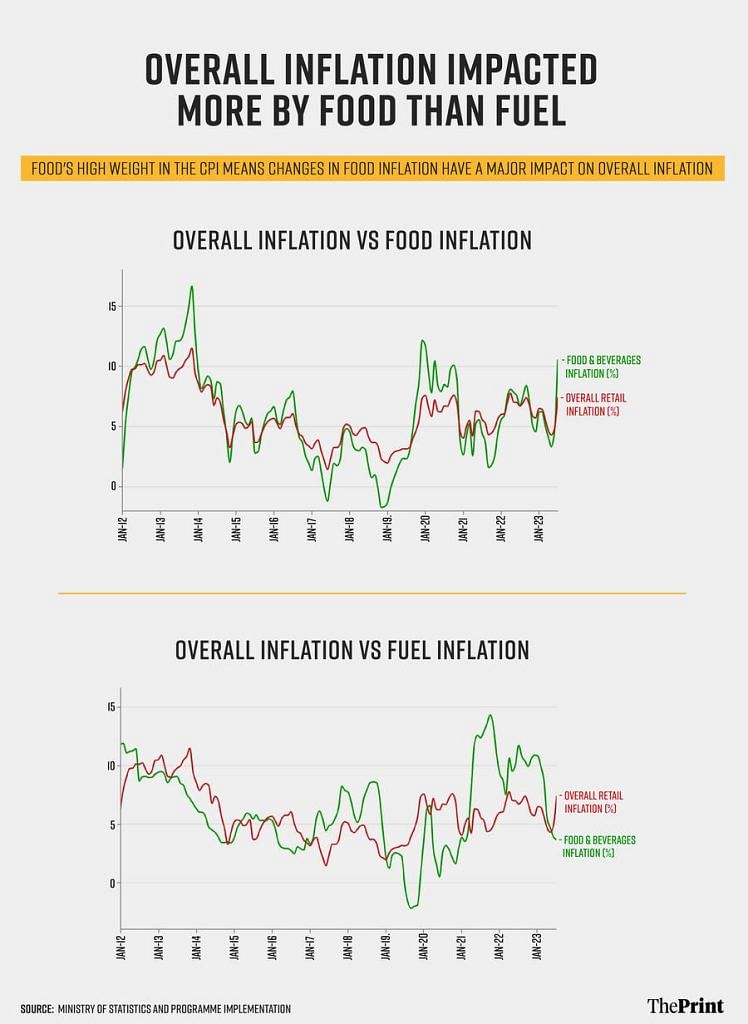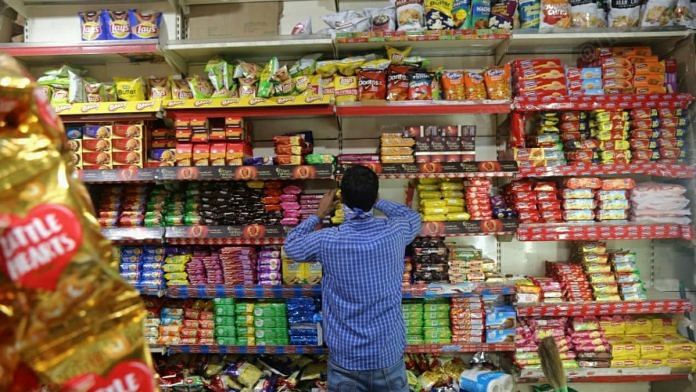New Delhi: India’s inflation data is not capturing the real impact of rising prices on the people, shows a combination of economic analysis, statisticians’ views, and anecdotal evidence. This is because the notion of an ‘average Indian’ has changed significantly since 2011-12, when the inflation parameters were last updated.
Retail inflation, as measured by the Consumer Price Index (CPI), came in at 7.4 percent in July. However, the data shows that this was driven by rising prices of food articles—which have been assigned a high weightage of 45.86 percent in the overall index.
A higher weightage means that changes in this category have a much bigger impact on the overall index than changes in categories with lower weightages, such as fuel. So, a spike in food prices will definitely cause the overall rate to surge, but a similar spike in fuel prices on its own will not result in a similar jump.

Analysis of the data in the CPI over time shows that overall inflation moves in close alignment with inflation in the food category, but its relationship with inflation in the fuel and light category is not as strong.
It is this weightage system that is rendering the inflation data inaccurate. These weights were assigned based on consumption patterns based on the Household Consumption Expenditure Survey (CES), which the government last conducted for the year 2011-12.
According to Pronab Sen, chairman of the Standing Committee on Statistics and former Chief Statistician of India, the problem is that consumption patterns have changed significantly over the last 12 years. However, we only have a broad idea of these changes.
“Nobody can say that income levels have not changed over the last decade or more, but we don’t know how they have changed,” Sen told ThePrint. “Over the last 12 years or so, the income would have grown by 70 percent, if not more, in real terms overall. So, the consumption patterns have had to have changed, and in some cases, quite dramatically.”
For example, the consumption patterns in food have changed significantly. As people see their incomes increasing, they move from spending just on the basics like cereals, potatoes, and onions, to higher categories like meat, fish, milk, and a wider variety of produce, all of which are more expensive on average.
“As people’s incomes rise, they will buy what people in the higher income groups are buying,” Sen explained. “But what also happens is that new things come into the market, which isn’t getting captured in the data.”
‘Weights for medical & education spends should be increased’
The issue of outdated weights in the Consumer Price Index isn’t exactly a new problem, but it has again gained significance due to growing awareness of the inordinate weightage assigned to food inflation in the overall measure of inflation.
Some scholars have directed their attention to the matter too.
In 2021, Radhika Pandey, Ananya Goyal, and Renuka Sane, researchers at the National Institute of Public Finance and Policy (NIPFP), published a working paper that analysed the weights based on the 2011-12 CES and a more recent, albeit smaller survey — the 2019 Consumer Pyramids Household Survey by the Centre for Monitoring Indian Economy’s (CMIE).
“Even though the sample is smaller, it does give an indication of how consumption has changed,” Pandey told ThePrint.
“We saw that, for some commodities, the difference between the weights in the CES and their share in actual expenditure as per CMIE’s survey was not too much. But for things like education, health, and medical expenses, the share of actual expenditure is far larger than what was measured in the last CES,” she said.
“It means that the weightage for food items in the CPI is more than it should be, while the weights for medical and educational expenditure needs to be increased,” she added.
What is happening, but is not being captured in the consumption data, is that private schools, with higher fees, are seeing their share in overall student enrollments rising rapidly, Sen explained, adding that the last decade has also seen a surge in the tuition industry, which also adds to overall expenditure on education.
“Something similar is happening in healthcare, where people are using more private hospitals,” he explained.
Also Read: Modi blames ‘imported inflation’ in I-Day speech, but data shows domestic veggie prices the culprit
How CPI weights underestimate inflation
ThePrint conducted a rudimentary analysis comparing the weights of different items in the CPI with their share in a household’s overall expenditure as measured by the Ministry of Statistics’ Private Final Consumption Expenditure (PFCE) measure.
While this comparison may lack the statistical rigour required to form detailed judgments, it does provide a broad glimpse into current consumption patterns.
For example, while food has a 45.86 percent weight in the CPI, the PFCE data shows it makes up just 30.2 percent of a household’s overall expenditure.
Notably, within the food category, cereals carry an overall weight of 9.67 percent in the CPI and a weight of as much as 12.35 percent for rural India. This, at a time when 80 crore poor people are getting foodgrains for free.
The CPI-PFCE comparison also shows that transport and communications, with a weight of just 8.6 percent in the CPI, make up about 19 percent of a household’s monthly expenditure.
“The notion of the average Indian, even the weighted average Indian that is captured by the CES, is outdated because the data we have of people’s incomes and expenditure patterns is more than 12 years old,” Sen said.
“This would be rectified if the latest Household Consumption Expenditure Survey was conducted and released— that’s the whole point of the survey. The CPI weights can be rebased according to that,” he concluded.
(Edited by Asavari Singh)
Also Read: You thought inflation’s high in India? Data shows at least 100 countries doing worse



